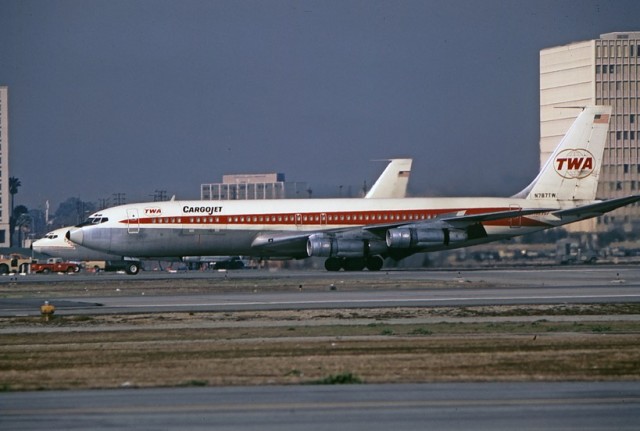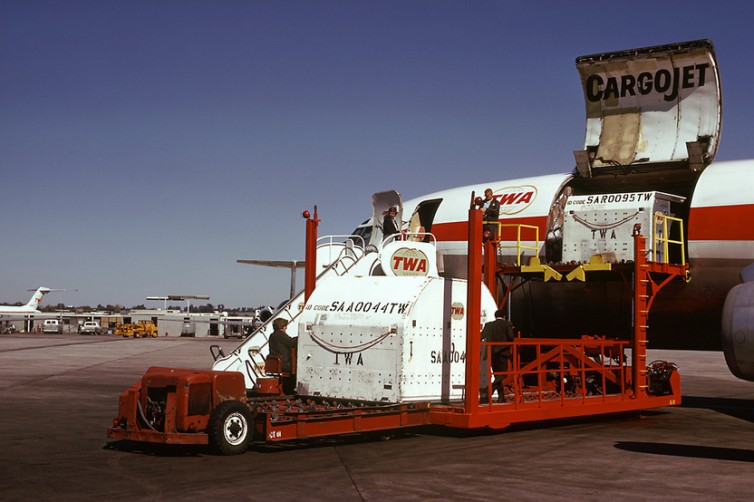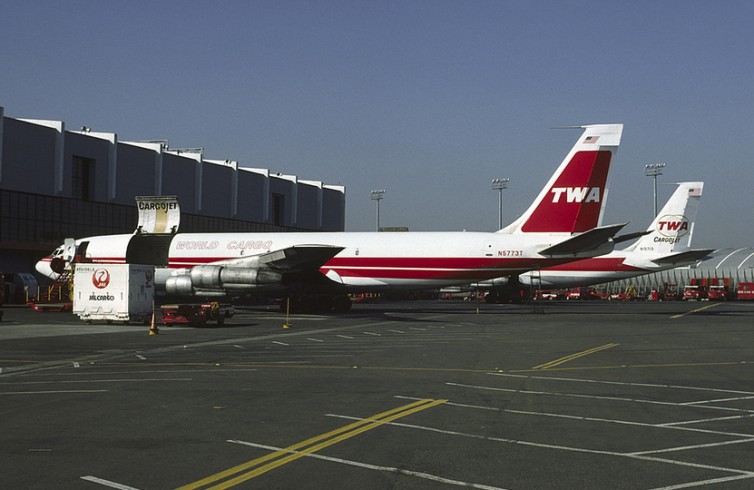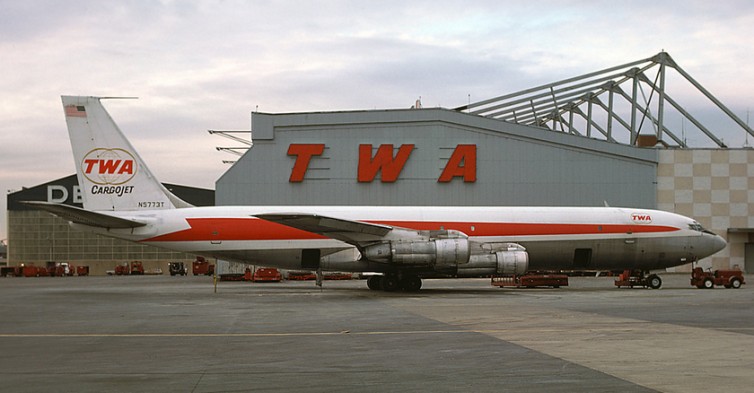
A TWA Boeing 707 freighter on Runway 25R at LAX – Photo: Jon Proctor
Here’s a little background about a wonderful encounter I had with racing legend Andy Granatelli in the late 1970’s. At that time, I flew for Trans World Airlines on their Boeing 707 and 727 aircraft.
In April and May of 1978, my regular assignment (trips for the month) was to fly a 707 freighter from Los Angeles to Indianapolis. Typically, we would launch very late in the evening around midnight, and arrive in Indy at around 6:00 am local time. A day-and-a-half later, we’d fly a return flight to Los Angeles at 6 pm. That gave us a 36-hour layover in Indy. On our first trip of the month, I got to the airport quite early, as I had been on vacation the previous month and had lots of accumulated paperwork to attend to. At about nine in the evening, I bummed a ride with a TWA mechanic from the hangar to the TWA cargo facility on the other side of the airport – probably the most harrowing part of my three-day trip.
As we arrived at the air freight terminal, I noticed two large box vans – both painted with the legendary STP logo. The TWA mechanic and I walked over to the vans and looked inside… one was filled with tires, crated engines, tool boxes, and other motor racing equipment. The second van had two Indy 500 race cars inside!
Andy Granatelli and two STP racecars – Photo: Indianapolis Speedway
There also were boxes of parts and several Nomex racing suits hanging in the front of the van. The mechanic headed back to the hangar and I went into Flight Ops. There I met Andy Granatelli – tan rain coat, briefcase, and all. He and his lawyer were checking the bill of laden which would allow TWA to haul their prizes from Los Angeles to Indianapolis.
I said hello to the operations gang in Flight Dispatch and then turned to introduce myself to Andy Granatelli and his lawyer. “Mr. Granatelli, nice to meet you, sir.” He asked if I was going to be flying the 707 freighter. I explained that I was one of three pilots on tonight’s flight to Indy. Tonto, the lawyer, made some snide remark about hoping I knew what I was doing because their “shipment” was worth millions of dollars. I was tempted to tell him that this was my first trip with TWA, but decided that probably would not be received with the intent I had in mind.
Tonto said Mr. Granatelli was going to be riding with this shipment as a courier – something that is allowed, even today. (In most cargo aircraft, there usually are one or two rows of first class seats immediately behind the cockpit). I assumed that Andy Granatelli would occupy one of those seats and hoped against all hope that Tonto would remain behind in Los Angeles to do his lawyering-thing with the TWA air cargo folks.

TWA 707 Cargo jet loading up pallets – Photo: George Hamlin
I asked Granatelli if we could take a closer look at the cars and other contents as they were being loaded on to the shipping pallets and igloos, and then into the airplane. Tonto, being ever vigilant, said there were secret design components which we could not look at without signing an NDA (non-disclosure agreement). Really? Yep, really.
Fortunately, about then, the captain arrived. Introductions were made all around and the rest of my crew and I boarded the aircraft. The captain and I busied ourselves with mundane pre-flight checks and procedures. I became aware that someone else was in the cockpit. Andy Granatelli stood there watching us as we flipped switches, dialed in various radio frequencies, compared departure, en route, and destination weather forecasts.
When there was a break in the liturgy, Andy asked if he could sit in the cockpit and watch. The captain asked if he was a courier and if he had the necessary paperwork with him. Granatelli opened his ever-present briefcase and took out the TWA forms the captain had asked about. Captain glanced at them and said as far as he was concerned Granatelli could ride in the cockpit all the way to Indy – as long as neither of the other crew members minded. Minded? This was a gift from the automobile gods.

Two different tail liveries on these TWA Boeing 707 Cargojets – Photo: George Hamlin
As we got closer to engine start, Granatelli had lots of questions about everything from fuel flow to turbine gas temperatures. (He had had a taste of turbine-powered race cars in the late 60’s). Because of Granatelli’s enthusiasm and exuberance, I remember the captain had to ask him to hold it down (conversation and questions) until we got under way.
As was nearly always the case with cargo flying, we were about an hour-and-a-half late departing Los Angeles. Once under way, and for the balance of the trip, we had unlimited access to Andy Granatelli – he told us about his passions, his concerns about the rule changes that had caused his turbine-powered race cars to no longer be allowed to compete, and he also shared lots of ’œbehind the scenes’ stories about everything from A. J. Foyt’s legendary temper to Mario Andretti’s infectious and irrepressible sense of humor. As we were about to start our descent into the Indianapolis terminal arrival area, Andy asked if he didn’t say anything, could he stay in the cockpit for the landing? Captain said that was fine as long as he just sat there and didn’t interfere or distract us. Also the captain told him he would have to vacate his cockpit jump seat while we were taxiing toward the cargo terminal.
Professional airline pilots pride themselves on making good landings… sort of a benchmark by which all pilots measure other pilots’ professionalism. On this early morning arrival into Indianapolis, the captain slicked this 240,000-pound airplane on. He literally rolled the aircraft onto the runway… no thump, no little second bounce – nothing. As we were rolling out toward the high-speed turn off, Andy Granatelli said something about that being the smoothest landing he’d ever felt… to which the captain mumbled something about ’œeven a pig finds a truffle occasionally…’

TWA 707 in front of their hangar in Boston – Photo: George Hamlin
As we taxied to the cargo ramp, Andy made his way back to the courier seats. While we were securing the cockpit, and the TWA ground crew were opening the large cargo door on the side of the aircraft, Andy came back to the cockpit and thanked us for a great trip. Once again he thanked the Captain for a very smooth landing.
As he turned to leave the cockpit and supervise the off-loading of his precious (and expensive) cargo, he handed each of us fully-unrestricted pit passes for entire months of April and May, 1978! With these passes, we would be authorized to go anywhere at the Indianapolis Motor Speedway, including driver meetings, gasoline alley, operations, infield, and grandstands. Our unlimited access was granted for every day in April and May, with the exception of race day. Even our magical pit passes wouldn’t work on the last day of May.
As it turned out, I flew several more of these cargo trips in April and May. We had the greatest time. Without a doubt those two months were some of the best experiences I had during my 25-year career flying for TWA. Not the most exciting, but the most enjoyable.
This story was written by C. J. Stott for AirlineReporter. Stott is a retired airline pilot with Trans World Airlines. He also graduated from Pepperdine University School of Law and his novel ’œHijacking of Flight 100’ is available on Amazon Books and Kindle.
Cool story! I’m a big fan of the Indy 500 and Indy 500 history so this is a really cool story to read.
Thanks! This was right up my alley, with my dual interest in airlines and Indy cars (TWA was my favorite airline in the 60s and 70s, and I grew up in Speedway, Indiana), but one photo caught my eye.
In the image of Granatelli with his cars and drivers, I believe we have Parnelli Jones, Lotus Cars’ founder Colin Chapman (standing with Granatelli), and Jimmy Clark (on the right). I found the same photo on the internet with this caption:
“The very last picture from Jim Clark in the new wedge Lotus STP Turbine,in the ’68 Indy 500 tests,8 days after,Jimmy will be fatally injured in a Formula Two race at Hockenheim Motor Drome”. Wow…
Great story but as a aviator the difference between hanger and hangar is quite extensive. I have never seen my plane in a hanger only in a hangar.
Yup. Hanger is not quite the same as a hangar. Updated – thanks for the catch.
David, AirlineReporter
Great comment Eric, but as an internet grammar policeman the difference between the indefinite articles a and an is quite extensive. I have never seen a aviator, but I have seen an aviator.
i enjoy the Indy 500 and had met Dario Franchiti while he was recovering from a previous back surgery.
He was a delightful young man and my husband and I spent a nice afternoon talking with him and the
charming Ashley Judd.
I worked for TWA at LAX as A/C mechanic. On graveyard, many nights at cargo area. In the 60’s, 70’s, 80’s and 90’s. Saw a lot of things.
I worked for TWA in Flight ops for 15 years. CLE – OHIO. Many many funny stories.
Hank Bott
hb**********@ju**.com